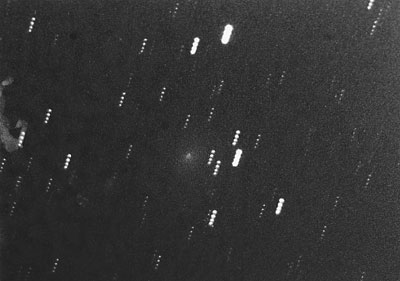Observation results and photo of 177P/Barnard 2
Judging from yesterday's weather, I think that the rainy
season has finally ended, but the air is still moist causing the clouds
to spread all over the sky at night. Tonight was not an exception. I left
home under a cloudless sky, but around the time I arrived at the observatory
in the evening, vividly white clouds rolled over from the sea in the south.
It even rained late at night.
I have been interested in the magnitude of 177P/Barnard 2.
I observed it with the 20cm refractor at 60x through the gaps in the fast
drifting clouds. The comet was unexpectedly large and at 10th magnitude
with a diffused coma, providing a typical appearance of a comet. It is
often the case that, while the comet's photographic magnitude is faint,
visually it appears much brighter. Barnard must have captured the image
like this with his 16cm comet seeker. "This IS the comet that the
great astronomer Barnard had discovered!" I was immensely thrilled
looking at Barnard's comet 117 years after its discovery.
The following are the total visual magnitudes:
177P/Barnard 2
2006UT RA (2000.0) Dec. m1
July 26.48524 16 57 42.56 +20 52 51.9 9.7 372
26.49715 16 57 41.86 +20 53 56.1 9.7 372
I managed to photograph the comet using the Metcalf method
over a period of 10 minutes through the gaps in the clouds. Its very sharp
nucleus was impressive and the coma appeared to spread endlessly. The total
magnitude is derived by adding up all such glow and tends to give surprisingly
bright magnitude values. The comet will likely brighten further and become
easier to observe in the northern sky.
Let's observe Barnard, which has returned to the 21st Century sky!

177P/Barnard 2
10-minute exposure from 21:20, July 26, 2006 J.S.T.
60cm f/3.5 reflector, TMY400 film

